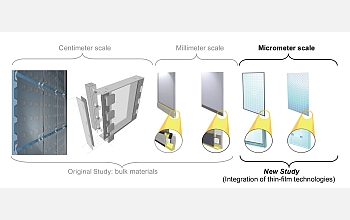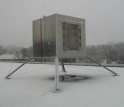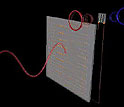News Release 06-104
Self-Cooling Soda Bottles?
Researchers work to shrink technology that harnesses sun's energy to both heat and cool

A schematic representation highlights the active building envelope (ABE) system.
July 11, 2006
This material is available primarily for archival purposes. Telephone numbers or other contact information may be out of date; please see current contact information at media contacts.
Every day, the sun bathes the planet in energy--free of charge--yet few systems can take advantage of that source for both heating and cooling. Now, researchers are making progress on a thin-film technology that adheres both solar cells and heat pumps onto surfaces, ultimately turning walls, windows, and maybe even soda bottles into climate control systems.
On July 12, 2006, Rensselaer Polytechnic Institute (RPI) researcher Steven Van Dessel and his colleagues will announce their most recent progress--including a computer model to help them simulate the climate within their test structure atop the RPI Student Union--at the Solar 2006 Conference in Denver, Colo.
For 4 years, the researchers have been working on their prototype Active Building Envelope (ABE) system. Comprised of solar panels, solid-state, thermoelectric heat pumps and a storage device to provide energy on rainy days (literally), the ABE system accomplishes the jobs of both cooling and heating, yet operates silently with no moving parts. NSF is supporting the team to determine if a microscale version of the technology will function effectively.
According to Van Dessel, thin-film advances could potentially lead to functional thermal coatings composed of transparent ABE systems. Such systems might vastly improve the efficiency of temperature-control systems.
"The ease of application would make it possible to seamlessly attach the system to various building surfaces," he added, "possibly rendering conventional air conditioning and heating equipment obsolete."
Van Dessel hopes a thin-film version of the ABE system will see uses in a range of industries, from aerospace--in advanced thermal control systems in future space missions--to the automotive industry, where it could be applied to windshields and sun roofs, giving them the ability to heat or cool a car's interior.
"It also may be possible to one day use the ABE system to create packaging materials for thermal control," he added, "which could lead to things like self-cooling soda bottles."
Additional information is available in the RPI press release linked below.
-NSF-
-
A working prototype of the original ABE system is located on the roof of RPI's Student Union.
Credit and Larger Version -
The ABE technology, still in developmental stages, can both heat and cool an enclosure.
Credit and Larger Version
Van Dessel will be giving a technical presentation on Wed., July 12th during the "Energy Efficiency, Renewable, and Green Technologies" session of the Solar 2006 conference, from 2:00-3:30 p.m. Van Dessel will discuss how the ABE system works, and the computational model he's developed to test the system's efficiency.
Abstract:
ISEC2006-99127; Technical
Development of a Computational Model for a Prototype Testing Room With Integrated ABE System
Authors: Steven Van Dessel and Xu Xu; Rensselaer Polytechnic Institute
Active Building Envelope (ABE) systems are a new technology for space heating and cooling, which integrate photovoltaic (PV) and thermoelectric (TE) technologies. In the ABE systems, a PV system is used to transfer solar energy directly into the electrical energy; this electrical energy is subsequently used to power a TE system. Depending on the direction of electrical current applied to the TE system, ABE systems can operate in a heating or cooling mode, and can compensate for thermal losses or gains that occur through a building's envelop or other thermal enclosure. ABE systems make use of solar energy, a clean and renewable energy resource. In order to assess the feasibility of the ABE system, we have developed a prototype ABE-window system. In conjunction with developing this prototype, we have also developed an outdoor testing room to test our ABE window system. Our current experimental setup allows us to measure the temperatures inside and outside of this window testing room.
To assess the effectiveness of the ABE system while in operation in the testing room, it is necessary to determine the comparative temperature for the same testing room without the TE system operating, for similar environmental conditions. There are two main methods to establish such control. The first method is to develop two identical experiments and test them simultaneously, one with, and one without, the ABE system in operating mode. The second method involves computing the indoor temperature through a simulation method. In our research we have opted for this second method.
In this study, we have built a computational model to predict the indoor temperature of an outdoor testing room and its integrated ABE system. The computational model uses the finite differential method, and includes the computation of solar radiation, heat transfer through the testing room surfaces and the ABE-window, and a model for the indoor air. We have verified the model's accuracy by comparing the simulation results of this model with actual temperature data. We have found that there was good correlation between the model's prediction for indoor temperature, and the actual temperature measurements for our testing room. The model will be used in further studies to assess the effectiveness of the ABE system.
Session: 5-1 Component Simulation-1
Media Contacts
Joshua A. Chamot, NSF, (703) 292-7730, email: jchamot@nsf.gov
Amber Cleveland, Rensselaer Polytechnic Institute, (518) 276-2146, email: clevea@rpi.edu
Program Contacts
Perumalsamy Balaguru, NSF, (703) 292-7016, email: pbalagur@nsf.gov
Principal Investigators
Steven Van Dessel, Rensselaer Polytechnic Institute, (518) 276-2011, email: vandes2@rpi.edu
Related Websites
Steven Van Dessel homepage: http://www.rpi.edu/~vandes2/abe.htm
Related RPI press release: http://news.rpi.edu/update.do?artcenterkey=1246&setappvar=page(1)
The U.S. National Science Foundation propels the nation forward by advancing fundamental research in all fields of science and engineering. NSF supports research and people by providing facilities, instruments and funding to support their ingenuity and sustain the U.S. as a global leader in research and innovation. With a fiscal year 2023 budget of $9.5 billion, NSF funds reach all 50 states through grants to nearly 2,000 colleges, universities and institutions. Each year, NSF receives more than 40,000 competitive proposals and makes about 11,000 new awards. Those awards include support for cooperative research with industry, Arctic and Antarctic research and operations, and U.S. participation in international scientific efforts.
Connect with us online
NSF website: nsf.gov
NSF News: nsf.gov/news
For News Media: nsf.gov/news/newsroom
Statistics: nsf.gov/statistics/
Awards database: nsf.gov/awardsearch/
Follow us on social
Twitter: twitter.com/NSF
Facebook: facebook.com/US.NSF
Instagram: instagram.com/nsfgov




